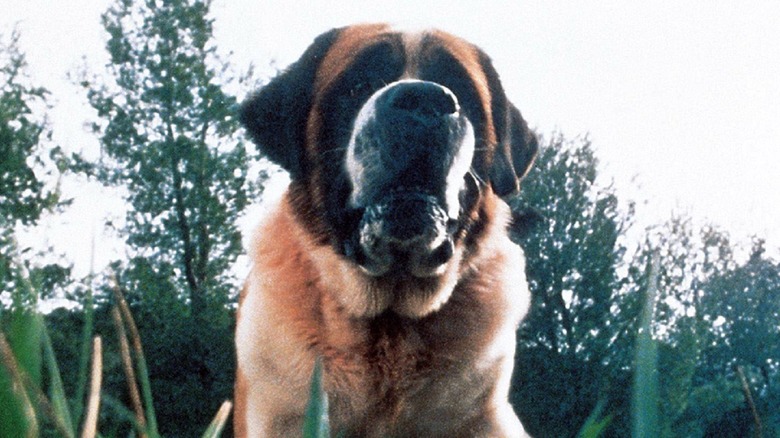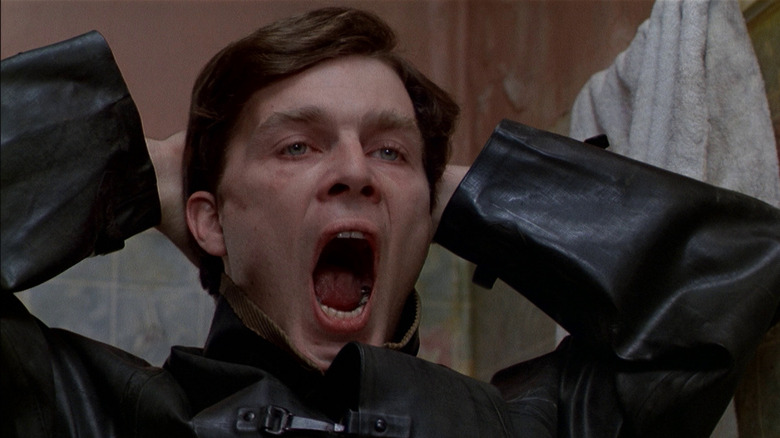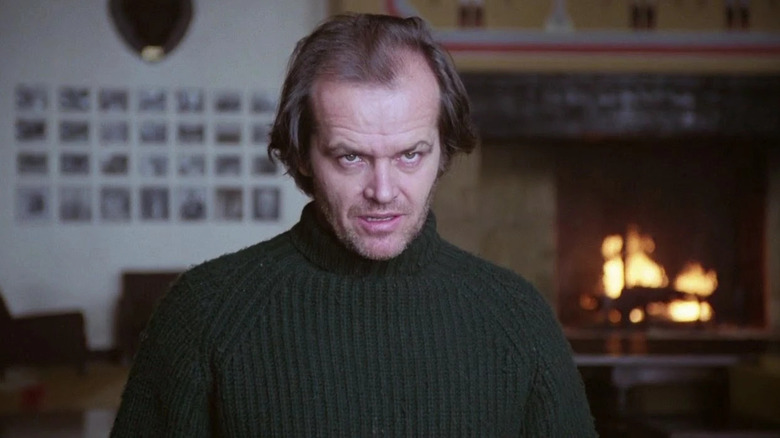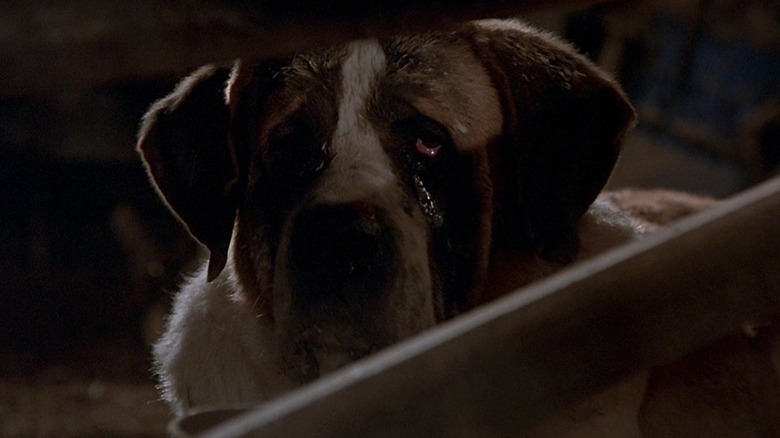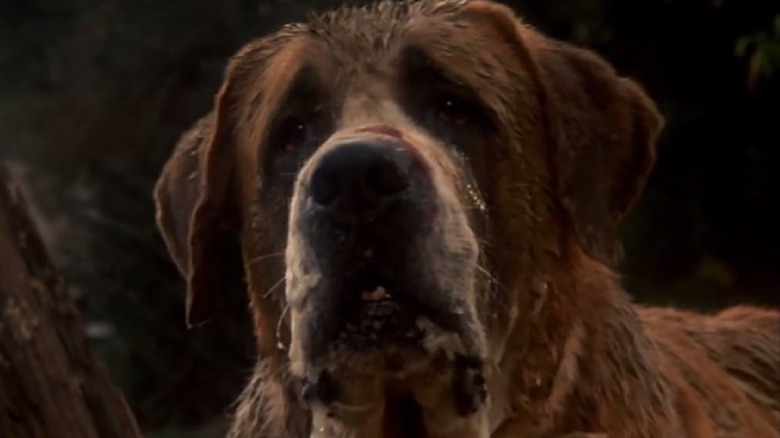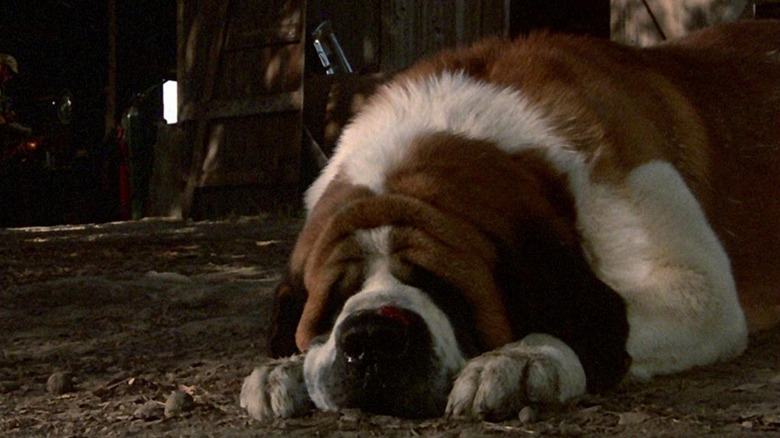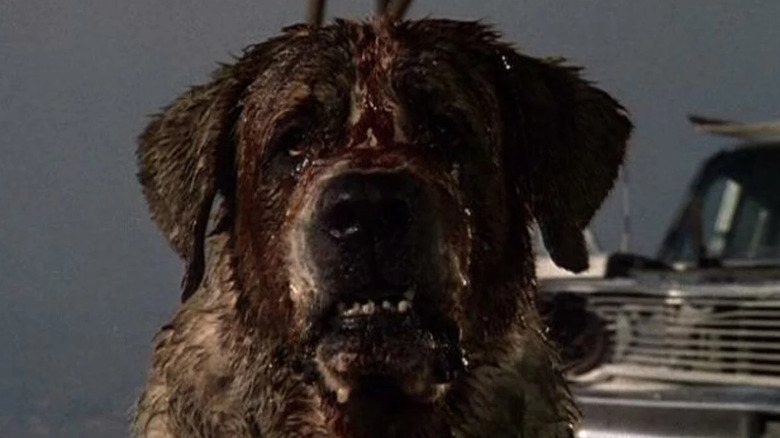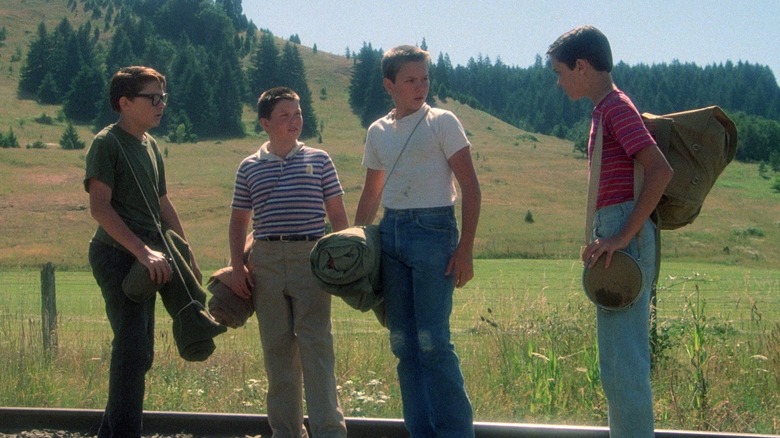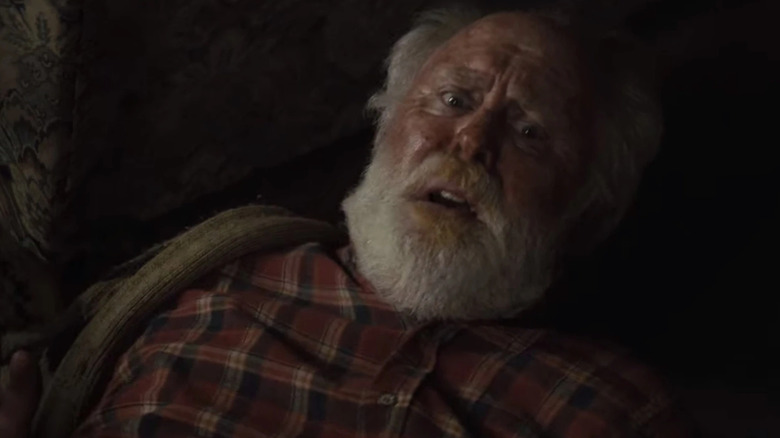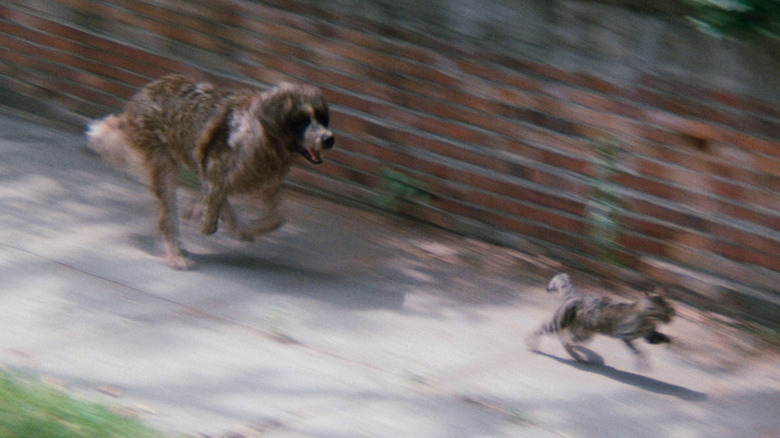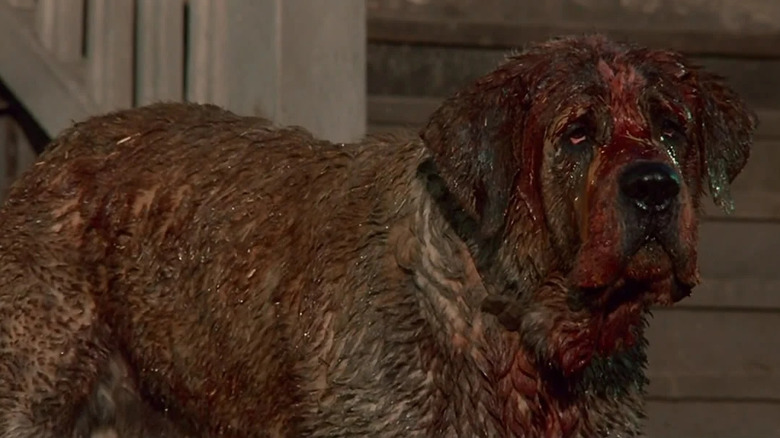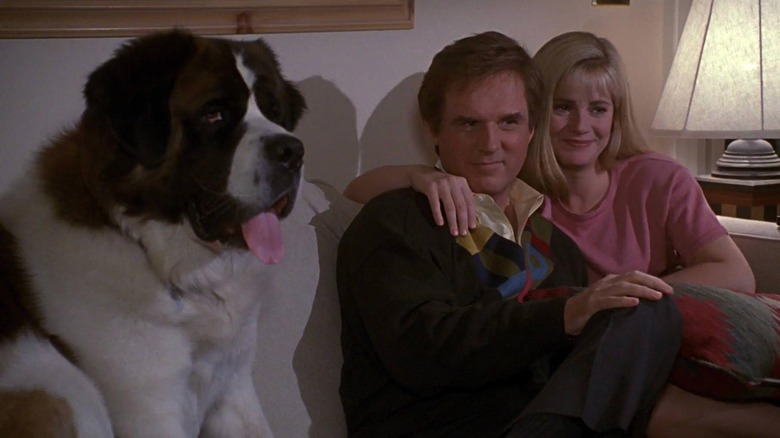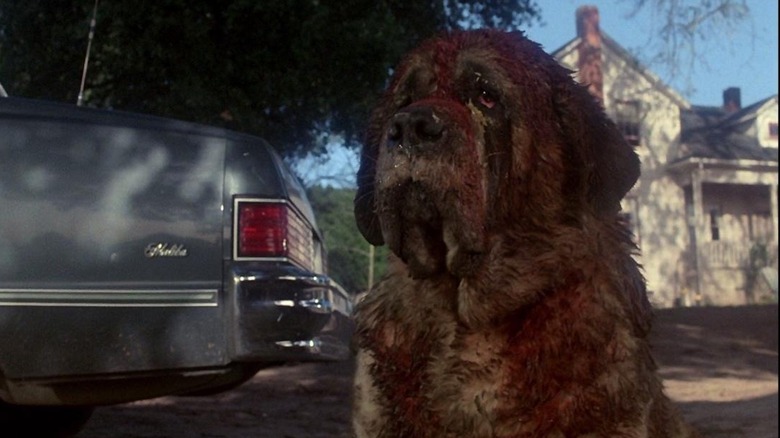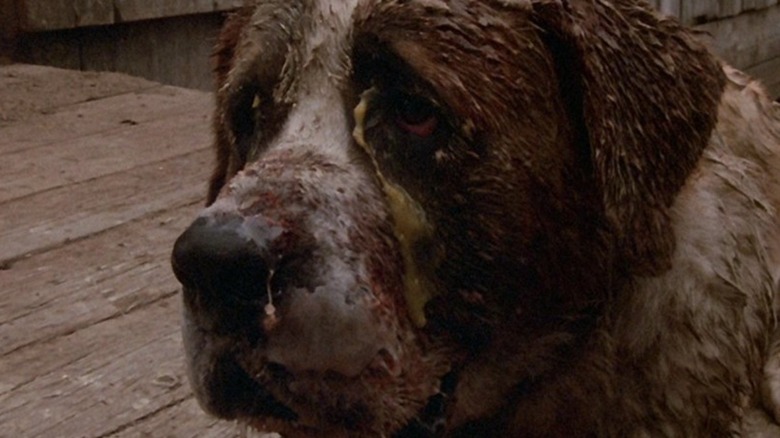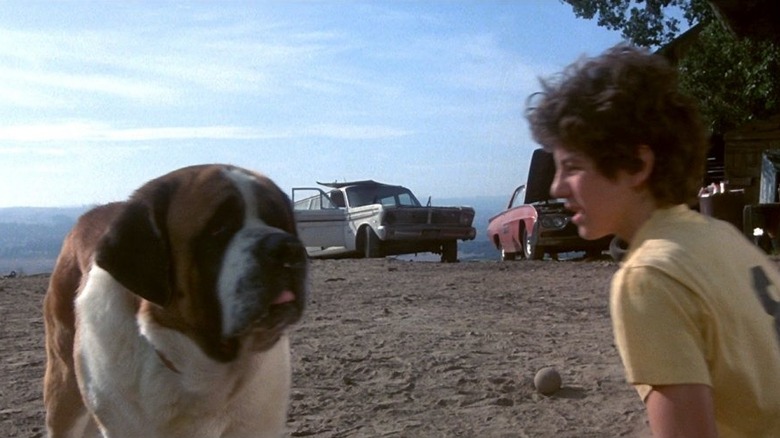The Dark History Of Cujo
One of legendary horror novelist Stephen King's foremost strengths as a writer is his ability to take everyday events and situations and turn them into intense subjects of horror and mystery. In his books, King can present even the most mundane topics in the most horrifying of ways, from idyllic Colorado hotels and cathartic high school proms to outwardly jolly clowns and pet cemeteries constructed by children. His 1981 novel, "Cujo," and its later 1983 film adaptation, is just one more example of this fact, taking an altogether simple premise and elevating it to bone-chilling levels of horror.
Cujo is the giant, fun-loving Saint Bernard belonging to the Cambers family who is bitten by a bat while playing in the fields of Castle Rock, Maine. Before their very eyes, the Cambers witness their lovable pet devolve into a rabid, demented wild animal out to kill everything in sight — including the Cambers themselves.
It's a scary premise made all the more terrifying by King's skilled writing, which focuses on Cujo's slow descent into madness and the beginning of his killing spree. Regardless of whether you read or watched the film version of "Cujo," there remain plenty of tiny details you might've missed about the infamous rampaging canine.
Here are some of the most interesting and obscure facts about the eponymous Cujo, such as the potential reasons for his nightmarish transformation and his appearances in later Stephen King stories.
The shift in Cujo's personality may be paranormal in nature
In both the novel and the 1983 movie adaptation of "Cujo," it's established that the primary reason for Cujo's transformation from a kind-natured, family-friendly dog to a maniacal, murdering wild animal is because Cujo has become infected by rabies. However, there are moments in King's original novel that hint Cujo's grisly personality change might also be the result of something far more sinister.
In the book, King alludes to a local serial killer active in the fictional town of Castle Rock, Maine, prior to the events of "Cujo." This killer — Frank Dodd — was initially featured in King's 1979 novel, "The Dead Zone." After the police learned his identity through the novel's protagonist, Johnny Smith, Dodd died by suicide to escape prosecution, leaving a confession behind proving their suspicions about him correct.
Fans and publications have widely theorized that Dodd's spirit is actually possessing Cujo, twisting his mind and allowing him to continue his killing spree from beyond the mortal realm. While that theory is far and away the most popular explanation behind Cujo's behavior, there may also be another, even darker reason for Cujo's rampage as well.
In the book, Tad is haunted by some sort of supernatural presence in his closet as Cujo's mentality slowly deteriorates. What exactly is this supernatural force in Tad's closet? Is Dodd the one possessing Cujo, or is there some sort of larger evil entity pervading Castle Rock? Perhaps Dodd himself was merely the victim of this same paranormal evil, just as how Jack Torrance became a vessel for the ghosts in "The Shining."
If you or anyone you know is having suicidal thoughts, please call the National Suicide Prevention Lifeline by dialing 988 or by calling 1-800-273-TALK (8255).
Cujo not being vaccinated ties into a prevalent theme in King's work
Looking at the general setup for "Cujo," the main catalyst for Cujo's transformation is the fact that he never actually receives a vaccination against rabies. Tracing this decision make to the family, it would appear that the person responsible for Cujo's lack of immunization is Joe, the abusive head of the Cambers family. Joe's lack of foresight and attention to Cujo ultimately contributes to Cujo's downfall (as well as the family's, by extension). Interestingly, though, the inattentiveness and domineering attitude of the Cambers' patriarch is actually a recurring theme in King's work.
Time and time again in his books, King has created an assortment of families whose troubles can be rooted back to the parent. Often, these parental figures are either completely absent from their family lives, emotionally neglectful, or physically/mentally bullying their families in some way, shape, or form. The idea of flawed parents is a prevailing subject throughout King's bibliography, and can perhaps best be seen in "The Shining" with Jack Torrance, Bev's father in "It," and Margaret White in "Carrie." In each of these stories, the parent's outright hostility towards their children or their neglectful attitude serves as the catalyst for some sort of frightening events — such as Cujo's eventual rabies contraction, as seen here.
If you or someone you know may be the victim of child abuse, please contact the Childhelp National Child Abuse Hotline at 1-800-4-A-Child (1-800-422-4453) or contact their live chat services.
Cujo's worst behaviors are triggered by fear
Shortly after he's bitten by the bat, Cujo's personality warps from a people-loving man's best friend into a more fearful, paranoid animal whose attitude to his owners completely changes. When once he was moved by a deep love and affection for the Cambers, Cujo begins to fear them instead, believing that he's done something wrong as a result of his being bitten by the bat in the first place.
Such a random shift in his attitude towards the Cambers marks the first steps toward his eventual transformation later on. The fear he begins to feel helps pave the way for his homicidal tendencies not only towards all humans in general but the Cambers specifically. As rabies asserts more and more influence over his mind, his fear of the Cambers only worsens, to the point where he sees them as literal monsters rather than the family he has bonded with for so many years previously.
It's out of this fear that Cujo adopts a more defensive "It's either them or me" mentality, electing to kill any humans he comes across before they're able to kill him.
The reason for Cujo's killings are expanded upon in the novel
In the film, Cujo's reason for suddenly turning on his human owners is explained as rabies-induced madness. In the novel, however, the exact details surrounding Cujo's homicidal turn are more fully explained. In the book, Cujo's murderous change is a result of Cujo's mental degradation, the dog having increasing difficulty telling humans apart. As the novel continues and Cujo's state degrades further, he begins seeing them as literal monsters, each of whom omits a loud sound that causes excruciating pain for Cujo whenever he draws too near.
By the third act of the book, Cujo's mind has devolved so greatly, he is almost completely unable to tell any humans — including his own owners, the Cambers — apart from these monsters. Viewing each human he comes across as this sound-producing monster, Cujo kills people not out of a conscious love for killing or because he's developed a taste for human flesh. Instead, he only seeks a way for the sound to stop, his pain momentarily easing every time he mauls a person who comes too close to him.
Cujo initially tried to stop his murderous urges
After being bitten by the rabid bat halfway through the novel, the human characters become aware of Cujo's gradually changing emotional state, watching as he devolves into a foaming, short-tempered creature with a desire to kill every human he sees in his path. However, they aren't the only ways to notice the slow shift in Cujo's personality. In the original novel, Stephen King spends lengthy passages focused entirely on Cujo's point of view, making it expressly clear that Cujo himself is also aware of his worsening physical and mental health.
Cujo instantly begins to take notice of his transformation, as well as his more malevolent newfound attitude toward his owners. As he continues to spend time with young Brett, he feels himself moved by the erratic urge to maul the boy, having difficulty separating his desire to kill from his love for Brett. Knowing he'll be unable to fend off these violent thoughts forever, Cujo forces himself to leave instead, to prevent any harm from coming to Brett. It's this detail that makes Cujo all the more tragic a figure — a character very much aware of his destructive tendencies, but powerless to do anything to stop them from getting any more out of hand.
Cujo's death was far more gruesome in the original novel
At the end of the film version of "Cujo," Cujo is killed in a fairly over-the-top way that most horror movie villains meet their demise. At the movie's climax, the film's heroine Donna Trenton (Dee Wallace) tries to escape from the Ford Pinto she and her son Tad have been trapped inside. Limping her away across the Cambers' yard, she uses a wooden bat to fend off Cujo, repeatedly beating him on the head each time he lunges at her. When the bat eventually snaps in two, she uses the broken handle as a makeshift wooden stake, thrusting it up upward when Cujo leaps on top of her, impaling him in the stomach. Seemingly dead, Cujo then miraculously recovers to attack the Trentons one last time, with Donna making a timely save by shooting the rabid dog dead once and for all.
As eventful as Cujo's death is in the movie, his literary counterpart's death was far more gruesome. In the book, Donna escapes her imprisonment in the Pinto, using a wooden bat to defend herself from Cujo's advances, as she does in the movie. The key difference between the book and the movie, however, is that, when the bat eventually breaks over Cujo's head, Donna uses the wooden shiv to stab Cujo through his eye, killing him instantly. After the police arrive at the scene and rescue the Trentons, Cujo's head is then removed from his body by the medical coroner and taken away for study.
The setting of Cujo is shared by several Stephen King stories
One of the more interesting aspects of Stephen King's stories is that they are all connected into one intricately shared universe. Like the MCU or the Tarantinoverse, most of King's novels and short stories contain some sort of connection that links them to another of his books. Sometimes, these links may be relatively small in nature (such as a minor character from one story appearing in another novel), while other times they can be much larger, such as one of King's go-to fictional locations.
When it comes to figuring out the story's placement in King's universe, one doesn't have to dig much farther than its setting: the town of Castle Rock, Maine. In terms of King's body of work, Castle Rock is one of the author's most populated cities, serving as the setting for some of his most famous works. Initially, it was used as the backdrop for his 1979 novel, "The Dead Zone," with "Cujo" the second novel to take place within the confines of the city.
In 1983, King placed the events of his novella, "The Body," in Castle Rock (although the 1986 adaptation, "Stand By Me," placed the story in Castle Rock, Oregon, rather than Maine). Castle Rock also appeared in King's novels "The Dark Half" and "Needful Things," and in numerous other short stories and novellas. Additionally, Castle Rock has been referenced in some of King's other beloved novels, like "It," "The Stand," "11/22/63," and "Under the Dome."
Cujo is occasionally mentioned in other Stephen King stories
As mentioned previously, characters from one Stephen King story have a way of appearing in another, completely different story later on. Oftentimes, these characters make a small cameo in King's later work, but they can also play a more important role in a novel's storyline — such as King's signature antagonist, Randall Flagg, who appears in several prominent novels and short stories. Other times, characters from one story might be indirectly referenced by a character in another story.
Such is the case for Cujo — his killings in Castle Rock later went on to achieve regional notoriety in the years that followed his massacre. Cujo and his infamous killing spree are referred to in a few Stephen King novels and short stories, including "The Dark Half" and "The Tommyknockers." Additionally, Cujo is also referenced in both the novel and the 2019 film version of "Pet Sematary."
In both cases, the homely next-door neighbor Jud Crandall (played in the 2019 film by John Lithgow) recounts Cujo's reign of terror in Castle Rock, referring to him as "a big old St. Bernard" who killed four people after contracting rabies. Although Cujo's name is not explicitly used in this instance, it's still interesting to note how often he appears in King's stories, even if his appearance and past crimes are only mentioned as a brief, throwaway easter egg on King's part.
Cujo appears in a handful of other Stephen King stories
Aside from the occasional references King makes to Cujo in his stories, there are some instances of Cujo himself actually appearing in other Stephen King books, short stories, and movies. For example, Cujo's spirit pops up in the 1991 novel, "Needful Things." In the story, a relative of the Camber family (the main family who owns Cujo in the book) visits the Cambers' house, long since abandoned after the events of "Cujo."
While there, she begins to overhear mysterious growling, suspecting that the ghost of the dog who killed her family members is still hanging around the Cambers' residence. Near the end of the scene, she even sees two burning red eyes staring at her from the darkness of the derelict barn, hinting that Cujo's presence isn't entirely in her mind after all.
In terms of his cinematic appearances, Cujo is also featured in the opening moments of the Stephen King-penned anthology film, 1985's "Cat's Eye." The scene in question finds a partially bloodied Cujo chasing a tomcat through the streets of a suburb, nearly getting run over by Christine, the titular 1958 Plymouth Fury in King's novel, "Christine." Judging from the amount of grime on Cujo's fur, this scene likely takes place either shortly before Cujo has killed Joe Cambers, as he is also able to interact with the humans around him in the film. Not only that but it's also been speculated that Cujo may be the title character in King's 1990 novella, "The Sun Dog," as well.
Cujo's physical deterioration reflects his worsening mindset
As startling as Cujo's mental degradation is over the course of "Cujo," just as terrifying is his physical transformation from a regular, clean-furred Saint Bernard into the bloody, viscera-covered dog we see by the end of the story. As the film version of "Cujo" progresses, we find Cujo doused in larger and larger amounts of gore, giving him the terrifying appearance he has at the movie's conclusion.
Interestingly, Cujo's blood-soaked appearance seems like an outward illustration of his worsening mental state. At the offset of his rabies infection, he appears with a somewhat grime-coated layer of dirt, assuming a more unkempt appearance to keep in line with his addled psyche.
When next we see him — just prior to his killing Joe — a noticeable layer of foam hangs from his mouth, a thick coat of mucus having formed at the corners of his eyes. By the time he appears at the climax of the film — menacing Donna and Tad in the Cambers' yard — Cujo is completely covered by a thick jacket of blood, foam, and slobber. Such a ghastly appearance can be seen as marking Cujo's slow descent into insanity, with his final appearance in the film showing just how far gone he is mentally by the end of "Cujo."
The dog trainer for Cujo later worked on Beethoven
Cujo has gone to become one of the most universally recognized dogs in all of fiction — as well as being the most generally feared among moviegoers and literary fans. In fact, in the years that followed "Cujo," Saint Bernards generally received a bad rap, not unlike everyone's avid fear of sharks after they've seen "Jaws" for the first time. Thankfully, the breed's reputation drastically improved with the release of 1992's "Beethoven," featuring a lovably chaotic Saint Bernard who is adopted by an uptight suburban family.
Coincidentally, both the film adaptation of "Cujo" and "Beethoven" employed the same animal handler to train their onscreen dogs. As one of the few animal wranglers in Hollywood capable of training Saint Bernards — an apparently difficult dog breed to work with on film — Miller found himself a valued staff member on the sets of both films, as revealed by the Los Angeles Times. As difficult as Saint Bernards are to train, however, Miller said he was happy to work on "Beethoven" and improve the image of Saint Bernards after "Cujo."
As Miller told the LA Times, "When 'Cujo' came out, I wasn't exactly the most popular dog trainer in the world among Saint Bernard owners." Regardless, it took Miller two whole months to find the right dog to play Beethoven in the film — further evidence of Saint Bernards' unruly nature on set.
Karl Miller begged the producers to use a different dog breed instead
As Karl Miller was one of the few trainers able to work with Saint Bernards, his expertise on animal behavior and training was of paramount importance during his time on "Cujo." However, Miller still made an effort to dissuade the film's producers from using a Saint Bernard in the film, as discussed in the documentary, "Dog Days: The Making of Cujo." As producer Daniel H. Blatt remembered it, Miller approached him with the request that they use a Doberman or some other dog breed as Cujo instead, telling Blatt, "There are no Saint Bernards who are trained."
Blatt refused, forcing Miller to cast multiple Saint Bernards as Cujo, each dog trained to fulfill a specific action on the film. Through clever editing techniques, the filmmakers then strung the scenes featuring the different dogs together, giving the illusion that Cujo was played by a single canine actor.
Miller later elaborated on the difficulty of working with a Saint Bernard in his interview with the Los Angeles Times. In the article, Miller explained that, because of their immense size and cuddly nature, Saint Bernards aren't the most active dog breed, nor do they have the same stamina or elegance in their movements as other kinds of dogs. "A Saint Bernard will run up a flight of stairs, but not as gracefully as a Doberman," Miller explained.
The foam used to simulate was actually a sugar and egg white mixture
As discussed previously, one of the most unsettling aspects about Cujo's character is his outward physical appearance. As the movie progresses and his formerly easygoing attitude vanishes, he undergoes a physical metamorphosis into a dog covered almost completely in blood. As part of his rabies infection, he can also be seen with wads of foam lining the corners of his mouth — best spotted in tight closeups on his face halfway through the movie.
In actuality, the substance used to simulate rabies-triggered foam was an apparently delicious mixture made from a sugar and egg white combination. When it came to applying the foam to the Saint Bernards used in the film, however, the filmmakers found themselves with an unforeseen issue. Whenever the crew covered the dogs' mouth with the concoction, the dogs almost instantly licked the foam off. As a result, the director had to film each scene quickly after the foam was applied to the dogs, likely also explaining why the foam is only occasionally shown in the film.
Critics believe that Cujo may be an allegory for Stephen King's alcoholism
"Cujo" may be a frightening read in its own right, but even more frightening is hearing about the story's background from author Stephen King. Throughout the late '70s and 1980s, King was battling an increasingly problematic drug and alcohol addiction. By King's own admission in his nonfiction book, "On Writing," his substance abuse had spiraled so far out of control by the early '80s, he can hardly remember writing "Cujo" at all.
"Cujo" marked the last book King wrote under the influence of drugs and alcohol, his family staging a successful intervention for the author after the novel's publication. By the late 1980s, King was completely sober, and returned to writing free from the restraints of alcohol or drug dependency.
Looking back to when King was facing the worst of his problems, multiple critics have expressed their belief that "Cujo" may be an illustration of King's inner fight with substance abuse. The Guardian's James Smythe noted the similar themes between "Cujo" and King's personal life, pointing out how Cujo's character arc may have reflected King's subconscious mind manifesting itself in the form of the killer dog. After all, Cujo (like King) is a generally good-natured creature; it's only when under the influence of a disease (rabies/alcohol and drugs) that he becomes a mean-spirited animal who consequently harms those closest to him. King himself has never commented on this of course, but it is interesting to see how closely the two stories align — although, fortunately, King managed to resolve his issues, unlike the hapless dog in his novel.
If you or anyone you know needs help with addiction issues, help is available. Visit the Substance Abuse and Mental Health Services Administration website or contact SAMHSA's National Helpline at 1-800-662-HELP (4357).\
The ending may not be as happy as you think
The novel version of "Cujo" ends with a lengthier epilogue that explains what happens after Donna kills Cujo. As in the movie, Donna is rescued and receives medical attention for her injuries, and the notable difference is that Tad has died from the heat stroke and dehydration he suffered in the broken-down Pinto. As she recovers from her wounds, Donna and Vic rekindle their marriage, seeking mutual support from each other over the shared loss of their son. Devastated by the death of his dog, Charity Cambers gifts her young son Brett a new, fully vaccinated puppy he can care for in lieu of Cujo. This ending may seem like an idyllic one, but several critics have pointed out that the novel's conclusion may not be as happy as it seems.
Referring once again to James Smythe's review of the novel in The Guardian, Smythe points out that the Cambers' new puppy being immunized against rabies matters little in the long run. Just because it's able to avoid catching rabies doesn't necessarily mean it won't share the same fate as Cujo's. As Smythe writes, "The potential for what [the dog] could do, how it could turn on you, is always inside it." This is especially true if you take into account Cujo's transformation may have been due to Frank Dodd — or something far more malevolent — influencing his mind, twisting him into the primal creature he is by the novel's end.
